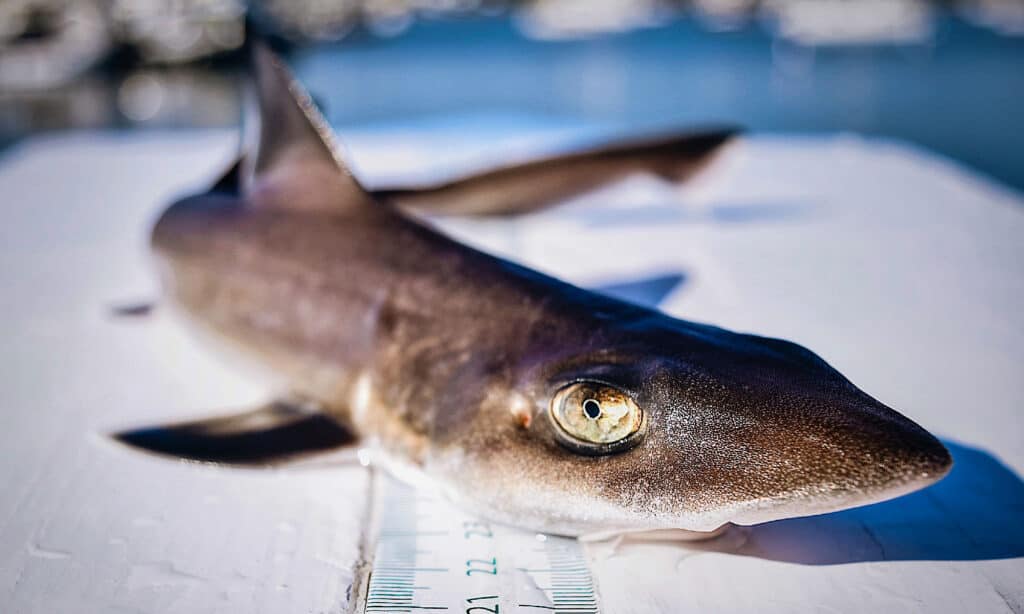Long Island Sound is a sound and tidal estuary of the Atlantic Ocean between Connecticut and New York State. It’s about 110 miles long from the East River in New York City and 21 miles wide at its widest point. The Long Island Sound also varies in depth, with some places reaching 230 feet deep. With how large this sound is, you can imagine that many animals call it home, including sharks. Although only four common sharks are living here, a few stragglers come to visit or travel through the area. Follow along to discover the 6 sharks found in the Long Island Sound and fun facts about each species.

Are Sharks Common in Long Island Sound?
While sharks live in the Long Island Sound, they aren’t super common. It’s unlikely you’ll encounter a shark every time you visit Long Island Sound Beach, but this doesn’t mean they aren’t in the area. Shark attacks are also very rare, especially in New York and Connecticut. For instance, Connecticut has only experienced three unprovoked shark attacks since 1890. The last was decades ago. New York has seen 20 attacks, 17 more than Connecticut, but since 1837. Still, these numbers are incredibly low considering how many people flock to the beaches during the summer. If you’re swimming on a Long Island Sound beach, you’re more at risk of drowning than being attacked by a shark.

Shark attacks in Long Island South are rare.
©WoodysPhotos/Shutterstock.com
6 Sharks Found in the Long Island South
Here we have 6 sharks found in the Long Island Sound, however, only 4 species are long-term residents. The most common four sharks found in the Long Island Sound are the spiny dogfish, sand tiger shark, sandbar shark, and smooth dogfish. Bull sharks and great white sharks are occasional visitors, typically swimming into the Long Island Sound when traveling.
1. Spiny Dogfish

Spiny dogfish can reach up to 4 feet long.
©Boris Pamikov/Shutterstock.com
The first shark on our list is the spiny dogfish. This shark is also called the mud shark, spurdog, and piked shark. It’s a member of the Squalidae family. Spiny dogfish are small, about 2 to 4 feet long. Females are slightly larger than males and take longer to mature. These unique sharks live up to 70 years, but more commonly for about 30 to 40 years. Spiny dogfish have a white spots along their backs. They also have two sharp spines which they use to protect themselves from predators. When caught, these sharks arch their back and stab their assailant with their spines, releasing mild venom.
Spiny dogfish hunt in packs. They’ve been observed hunting in groups with over 1,000 other dogfish. Despite their small size, they have large and healthy appetites consuming squids, fish, shrimp, and jellyfish. Although spiny dogfish are one of the most common shark species in the world, they are classified as Vulnerable on the IUCN Red List.
2. Sand Tiger Shark

Sand tiger sharks are critically endangered.
©Stefan Pircher/Shutterstock.com
The next common shark in the Long Island Sound is the sand tiger shark. It’s also the most permanent aggressive shark in the water. This permanent resident is massive, growing up to 10.5 feet. Sand tiger sharks also weigh between 201 and 351 pounds. It has a pointy head and a large wide snout. Apart from its tiger shark markings, it’s also best known for its three rows of sharp teeth protruding out of its mouth.
Sand tiger sharks are excellent swimmers and live in most bodies of water up to 623 feet deep. They are nocturnal hunters and mainly consume large bony fish. They also hunt for sharks, crabs, and lobsters. During the day, sand tiger sharks stay hidden in reefs, caves, and overhangs. Although considered dangerous and aggressive, sand tiger sharks rarely interact with humans. They are also listed as Critically Endangered on the IUCN Red List.
3. Sandbar Shark

Great whites and tiger sharks prey on sandbar sharks.
©Vladimir Wrangel/Shutterstock.com
Sandbar sharks are also found in the Long Island Sound. On the IUCN list, they are listed as Endangered. Sandbar sharks are also called brown sharks. Although smaller, they are closely related to bull sharks. Male sandbar sharks grow up to 5.9 feet long, while females can reach 8.2 feet long. They have smooth and plump bodies with short rounded snouts. Despite being called brown sharks, they aren’t always brown. Some sandbar sharks are blueish with white undersides.
Sandbar sharks aren’t picky. They live in tropical to temperate waters worldwide. However, they are mostly found in over muddy or sandy bottoms in coastal waters like bays, harbors, and estuaries. They have large diets but mainly hunt fish, crabs, and rays. Small sandbar sharks are vulnerable and are sometimes attacked by tiger sharks or great whites.
4. Smooth Dogfish

Smooth dogfish are bottom dwellers but have been observed swimming in the open ocean as far deep as 665 feet deep.
©Rafeed Hussain/Shutterstock.com
The last common shark in the Long Island Sound is the smooth dogfish, which closely resembles the spiny dogfish. The smooth dogfish has many names including the dog shark, dusky smooth-hound, and nurse shark. This shark species is a member of the Triakidae family. Although common, it’s listed as Near Threatened on the IUCN Red List. This small and slender shark grows up to 5 feet long but is usually about 48 inches. They don’t have any fin spines and change color to camouflage themselves from predators.
These smooth and harmless sharks live in marine and brackish waters. They aren’t picky and spend their time swimming in open water and dwelling at the bottom. You can find them on the East Coast of the United States, including Long Island Sound. While they prefer shallow water, smooth dogfish have been found as far deep as 665 feet.
5. Great White Shark

Great white sharks only have one natural predator, orca whales.
©Martin Prochazkacz/Shutterstock.com
Great white sharks aren’t a common shark species in the Long Island Sound, but that doesn’t mean they don’t occasionally pass through. For the first time, a great white shark was recorded in Long Island Sound in 2019. It was nearly 10 feet long and weighed 500 pounds. Cabot, the shark researchers tracked in Long Island Sound, didn’t stick around for long as it made its way to the Hamptons.
Great white sharks are fascinating. They are massive apex predators that can measure up to 20 feet long. Females are larger than males weighing between 1,500 and 2,450 pounds. Male great white sharks typically reach about 11 to 13 feet long. Although they rarely interact with humans, they are considered aggressive and dangerous because of their power and size. One powerful bite is enough to tear limbs, even after letting go. Great whites though don’t target humans. Instead, they hunt large fish, whales, dolphins, sea turtles, and sea lions. Although great whites are apex predators, orca whales have been recorded attacking and killing great whites.
6. Bull Shark

Bull sharks are rare in Long Island Sound.
©Ian Scott/Shutterstock.com
The last shark on our list is just as rare as the great white. Chances are, you’ll likely never see a bull shark in Long Island Sound, and you don’t want to either. Bull sharks are considered aggressive, however, shark attacks are rare. Divers have also swum alongside bull sharks with little to no reaction. Most shark attacks occur because the shark either feels threatened or mistakes the human for a fish, seal, or turtle.
Bull sharks are large sharks, like great whites. They are about 7 to 8 feet long, with the largest recorded bull shark measuring 13 feet. However, this is rare and unlikely. Bull sharks are wide and excellent swimmers. They can enter rivers and brackish waters. Bull sharks aren’t picky eaters. They hunt fish, stingrays, dolphins, and birds.
Summary of 6 Sharks Found in Long Island Sound
| Shark | Fun Fact | |
|---|---|---|
| 1 | Spiny Dogfish | They hunt in packs of up to 1,000 |
| 2 | Sand Tiger Shark | Three rows of long, protruding teeth are its most prominent feature |
| 3 | Sandbar Shark | These endangered sharks like to live in muddy water in bays |
| 4 | Smooth Dogfish | Dogfish are harmless bottom dwellers |
| 5 | Great White Shark | Males can grow to 20 feet in length and weigh up to 2,450 pounds |
| 6 | Bull Shark | These aggressive sharks can enter rivers and brackish waters |
Thank you for reading! Have some feedback for us? Contact the AZ Animals editorial team.








